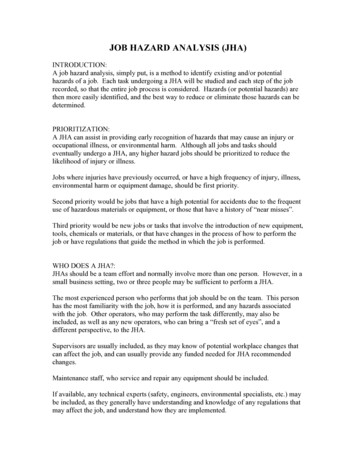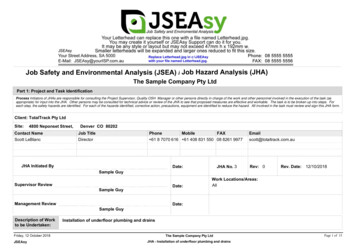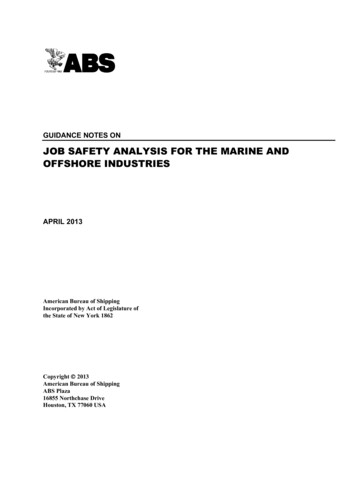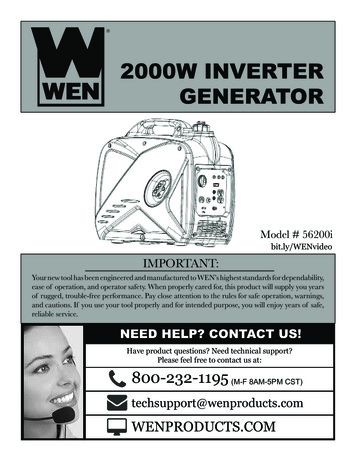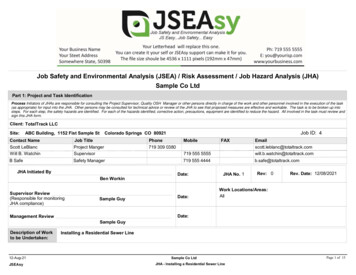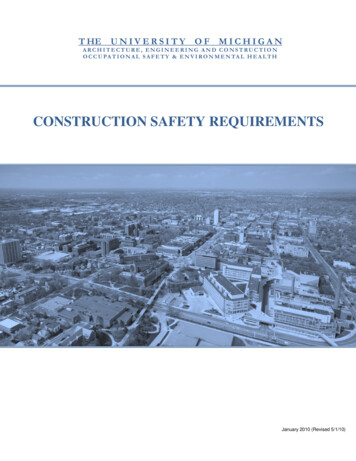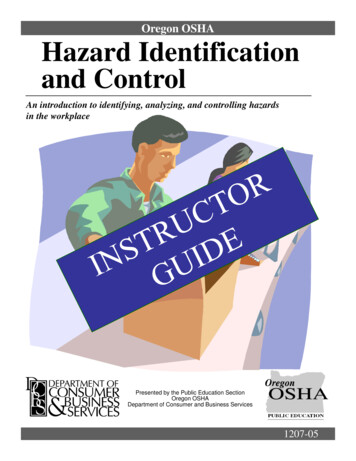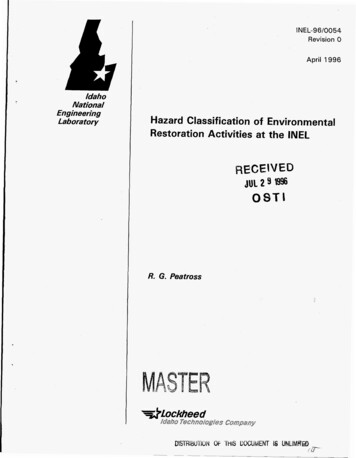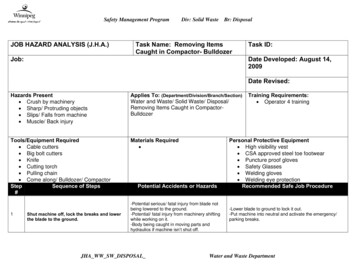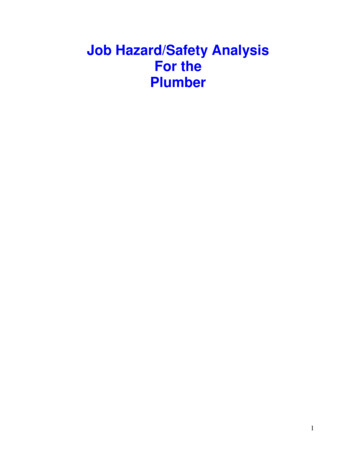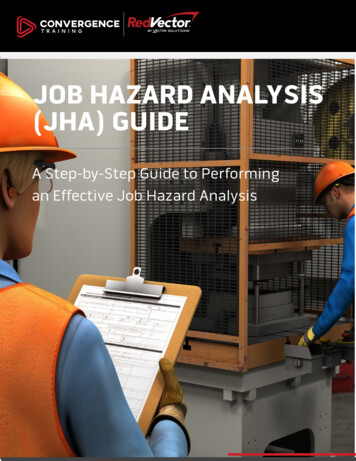
Transcription
JOB HAZARD ANALYSIS(JHA) GUIDEA Step-by-Step Guide to Performingan Effective Job Hazard Analysis
This guide to performing a JHA has been created by ConvergenceTraining/RedVector and incorporates suggestions made in OSHA’s Job HazardAnalysis booklet (OSHA 3071, revised in 2002). You can use it to help youperform JHAs at your worksite.This guide was originally downloaded from the Convergence Training blogand was part of an extensive article on JHAs. Check out the ConvergenceTraining blog for more helpful information on safety, safety training, andother training needs: https://www.convergencetraining.com/blog.We also offer an online Job Hazard Analysis training course as part of ourEHS training library.This guide is divided into five parts:1. GETTING READY TO BEGIN A JHA: A CHECKLISTp.1Complete this list before performing a JHA for a specific job.2. COMPLETING A JHA: THE STEPSp.3Follow these steps to complete a JHA for a specific job.3. COMPLETING A JHA: A TEMPLATEp.5Use this 2-part template to complete a JHA. In the first part, break the job down into aseries of tasks. In the second part, perform a hazard analysis for each task.4. LIST OF POTENTIAL HAZARDSp.7Use this list of potential hazards as a guide to help you investigate potential hazardsassociated with each task.5. HAZARD CONTROL HIERARCHYUse this guide to hazard controls as a way to consider controlling the hazards you’veidentified.p.9
GETTING READY TO BEGIN A JHA (CHECKLIST)GETTING READY TO BEGINA JHA (CHECKLIST)Before you begin the JHA for a specific job, make sure you’ve donethe following:Make sure your employees are involvedPretty much everything related to safety works best when management andemployees are both involved. That’s true of the JHA process as well. Remember, it’stheir job, and they probably know it better than you do. This will also help you get theirbuy-in for this process and for safety in general. Plus, two (or more) sets of eyes arealways better than one.Did you do this? Y/NReview your history of injuries, illnesses, near misses, andmachine/tool damageGo over your written records of injuries, illnesses, near-misses, and incidents that haverequired machine/tool replacement or repair. Then, get feedback from youremployees, asking if there are things that have occurred but are not in the records (forwhatever reason–make it clear you’re trying to make work conditions safer, not punishanyone because something hasn’t been reported).Did you do this? Y/NJob Hazard Analysis (JHA): The Guide // 1
GETTING READY TO BEGIN A JHA (CHECKLIST)Ask your employees which hazards exist in their work areaAsk your employees if they’re aware of hazards in their work area. Write them down -you can use this list later when you’re performing the JHA.NOTE: If a serious hazard comes to light at this point, stop what you’re doing andcorrect the problem before you continue with the JHA process.Did you do this? Y/NCreate a list that prioritizes the jobs you’ll perform in a JHAIt’s great if you do a JHA for every job, but you should do JHAs for the jobs with thehighest risks first. Take the information you’ve already gathered and prioritize theorder in which you’ll perform the JHAs.Did you do this? Y/NWith these steps down, you’re now ready to complete the formal JHAprocess as described in the next section.Job Hazard Analysis (JHA): The Guide // 2
COMPLETING A JHA: THE STEPSCOMPLETING A JHA:THE STEPSSTEP 1 - BREAKING THE JOB DOWN INTO STEPS/TASKSBegin the JHA for a specific job by breaking the job down into the steps or tasksperformed while doing the job. Here are some ways to do this:· Watch an employee performing the job.· Ask the employee what the various steps are--the employee may have somegood insight here, but remember that the employee may leave out some stepsbecause they're "automatic" to him or her.· Ask other employees who have performed the job to list or review the steps.· Film the employee while the employee performs the jobs--this will help youidentify the steps.You can write these steps down any way you want. It's common to create a JHA formthat represents each task of a given job, plus a description of the task, the hazards,and potential hazard controls. We’ve included a sample template in the next section ofthis guide.STEP 2 - IDENTIFY HAZARDS ASSOCIATED WITH EACH TASKIdentify and list the hazards associated with each task (do one task first, then another,etc.). Consider every possible thing that could go wrong. How could the worker beinjured or be made ill? How could machines or equipment be damaged? Ask yourselfthe following questions:Job Hazard Analysis (JHA): The Guide // 3
COMPLETING A JHA: THE STEPS· What could go wrong?· What could cause that thing/those things to go wrong?· What other factors could contribute to that thing/those things going wrong?· What would happen if that thing/those things did go wrong?· How likely is it that that thing/those things will go wrong?Reviewing the table of hazards listed later in this guide (see section 4) may be veryhelpful when you're trying to identify hazards.STEP 3 - WRITE A HAZARD DESCRIPTIONWrite a description of the hazard (also called a hazard scenario) in a consistent, orderlymanner that will help ensure you will later put in steps to control the hazard andcreate the best possible controls. A good hazard description should include thefollowing items.· Environment: where does this hazard exist?· Exposure: who or what might be injured or made ill by this hazard?· Trigger: what event might cause the hazard to lead to an injury or illness?· Contributing factors: are there other factors that might contribute to causethe hazard to lead to an injury or illness?· Outcome/consequence: what would be the result if the hazard were to occur?Job Hazard Analysis (JHA): The Guide // 4
COMPLETING A JHA: A TWO-PART TEMPLATE // PART 1COMPLETING A JHA:A TWO-PART TEMPLATEUse this template, or one of your own, to fill out a JHA. Do Part 1 first toidentify each task. Then, complete Part 2 for each task/hazard youidentified.JHA TEMPLATE PART 1: Write down the list of steps or tasksthat make up the jobTask 1 Task 2 Task 3 Task 4 Task 5 Task 6 Task 7 Task 8 Task 9 Task 10 Job Hazard Analysis (JHA): The Guide // 5
COMPLETING A JHA: A TWO-PART TEMPLATE // PART 2JHA TEMPLATE PART 2: Fill in the JHA FormJOB HAZARD ANALYSISGENERAL TIPSJob that Task is Part ofJob Location/Work AreaJHA Analyst (Name & Title)Date of JHAJob Task -- DescriptionHazard Description/ScenarioSuggested Hazard ControlsAdditional NotesWere Hazard Controls PutInto Place? If so, When?When should JHA beReviewed/Revised Again?When was JHA LastReviewed/Revised?Job Hazard Analysis (JHA): The Guide // 6
HAZARD LISTHAZARD LISTA hazard is something that has the potential to cause harm. Typically, this meanssomething that can cause an injury or illness. Here’s a list of many possible types ofhazards. Use this list to help you search for hazards associated with each task in a job.Chemical (toxic): A chemical that exposes a person by absorption through the skin, inhalation, orthrough the bloodstream that causes illness, disease, or death. The amount of chemical exposure iscritical in determining hazardous effects. Check Safety Data Sheets (SDS) and/or OSHA 1910.1000for chemical hazard information.Chemical (flammable): A chemical that, when exposed to a heat ignition source, results incombustion. Typically, the lower a chemical’s flash point and boiling point, the more flammable thechemical. Check SDS for flammability information.Chemical (corrosive): A chemical that, when it comes into contact with skin, metal, or othermaterials, damages the materials. Acids and bases are examples of corrosives.Explosion (chemical reaction): Explosions caused by chemical reactions.Explosion (over pressurization): Sudden and violent release of a large amount of gas/energy dueto a significant pressure difference, such as rupture in a boiler or compressed gas cylinder.Electrical (shock/short circuit): Contact with exposed conductors or a device that is incorrectlyor inadvertently grounded, such as when a metal ladder comes into contact with power lines. 60Hzalternating current (common house current) is very dangerous because it can stop the heart.Electrical (fire): Use of electrical power that results in electrical overheating or arcing to the pointof combustion or ignition of flammables, or electrical component damage.Electrical [static/electrostatic discharge (ESD)]: The moving or rubbing of wool, nylon, othersynthetic fibers, and even flowing liquids can generate static electricity. This creates an excess ordeficiency of electrons on the surface of material that discharges (spark) to the ground resultingin the ignition of flammables or damage to electronics or the body’s nervous system.Electrical (loss of power): Safety-critical equipment failure as a result of loss of power.Job Hazard Analysis (JHA): The Guide // 7
HAZARD LISTErgonomics (strain): Damage of tissue due to overexertion (strains and sprains) or repetitivemotion.Ergonomics (human error): A system design, procedure, or equipment that tends to lead tohuman error. (For example, a switch that goes up to turn something off instead of down).Excavation (collapse): Soil collapse in a trench or excavation as a result of improper or inadequateshoring. Soil type is critical in determining the hazard likelihood.Fall (slips and trips): Conditions that result in falls (impacts) from height or traditional walkingsurfaces (like slippery floors, poor housekeeping, uneven walking surfaces, exposed ledges, etc.).Fire/heat: Temperatures that can cause burns to the skin or damage to other organs. Fires requirea heat source, fuel, and oxygen.Mechanical/vibration (chaffing/fatigue): Vibration that can cause damage to nerve endings, ormaterial fatigue that results in a safety-critical failure. (Examples are abraded slings and ropes,weakened hoses and belts.)Mechanical failure: Self-explanatory; typically occurs when devices exceed designed capacity orare inadequately maintained.Mechanical: Skin, muscle, or body part exposed to crushing, caught-between, cutting, tearing,shearing items or equipment.Noise: Noise levels ( 85 dBA 8 hr TWA) that result in hearing damage or inability to communicatesafety-critical information.Radiation (ionizing): Alpha, Beta, Gamma, neutral particles, and X-rays that cause injury (tissuedamage) by ionization of cellular components.Radiation (non-ionizing): Ultraviolet, visible light, infrared, and microwaves that cause injury totissue by thermal or photochemical means.Struck-by (mass acceleration): Accelerated mass that strikes the body causing injury or death.(Examples are falling objects and projectiles.)Struck against: Injury to a body part as a result of coming into contact of a surface in which actionwas initiated by the person. (An example is when a screwdriver slips.)Extreme temperatures (hot/cold): Temperatures that result in heat stress, exhaustion, ormetabolic slow down such as hypothermia.Visibility: Lack of lighting or obstructed vision that results in an error or other hazard.Weather conditions (snow/rain/wind/ice): Self-explanatory.Job Hazard Analysis (JHA): The Guide // 8
THE HIERARCHY OF HAZARD CONTROLSTHE HIERARCHY OFHAZARD CONTROLSOnce you've written the hazard descriptions, now it's time to brainstorm somehazard controls so the hazard never really does lead to an injury or illness. Here’s theHierarchy of Controls to help you with this.When you're considering a list of controls, think of the following, and try to implementthem in the order below. In reality, you may have to use several different types ofcontrols to fully control the hazard.1. Elimination, Minimization, and/or SubstitutionIf you can remove the hazard entirely, or put some form of substitute in place, dothat. That’s the best way to deal with a hazard—make it go away. An example would beremoving a sharp edge on the corner of a machine so nobody could get cut.This may include:· Designing or redesigning a facility, equipment, or process to eliminate orminimize the hazard· Substituting processes, equipment, materials, or other factors to eliminate orminimize the hazard· Other solutions2. Engineering ControlsEngineering controls involve re-designing the work area so that the hazard iseliminated or reduced. An example would be enclosing a noisy motor inside asound-proof box.Job Hazard Analysis (JHA): The Guide // 9
THE HIERARCHY OF HAZARD CONTROLSEngineering controls may include:· Enclosing the hazard· Isolating the hazard with interlocks, machine guards, blast shields, weldingcurtains, or other means· Removing or redirecting the hazard, such as with exhaust ventilation· Other solutions3. Administrative ControlsAdministrative controls involve modifying the way people work around a hazard toreduce the risk. An example might be limiting the number of hours someone workslifting heavy boxes from the end of a conveyor belt.Examples of administrative controls might include:· Exposure time limits (often used for temperature extremes and ergonomichazards)· Monitoring the use of hazardous materials· Alarms, signs, and warnings· Buddy systems· Safety training4. Personal Protective Equipment (PPE)PPE can be used to protect people who are working in the presence of hazards. Anexample would be giving a respirator to someone working near airborne crystallinesilica. PPE should only be used as a last resort, once the other forms of controls listedabove have been tried. PPE may be used in combination with the other forms ofcontrols, too.Job Hazard Analysis (JHA): The Guide // 10
THE HIERARCHY OF HAZARD CONTROLSConsider using PPE in these instances:· When engineering controls aren’t feasible· When engineering controls don’t totally remove the hazard· While engineering controls are being developed· When safe work practices don’t provide sufficient additional protection· During emergencies when engineering controls may not be feasibleJob Hazard Analysis (JHA): The Guide // 11
ENVIRONMENTAL, HEALTH & SAFETY TRAINING COURSESOur online Environment, Health, and Safety (EHS) training courses cover manytopics, including:· Equipment Safety· Mining Safety· Health and Illness· First Aid· Cranes and Rigging· Driver Safety and DOT Compliance· Electrical Safety· Hazardous Chemicals· Hazwoper· Environmental· And more.Learn More About Our EHS Courses
INDUSTRIAL-STRENGTH SAFETY TRAINING MANAGEMENTThe Convergence Learning Management System (LMS) is a web-based softwaresystem that administers your entire EHS training program, including training thatoccurs “offline” and online. It’s designed specifically for industrial andmanufacturing facilities and can be used to manage all training, not just EHS. Itmakes the following a snap:· Assigning· Notifying· Delivering· Tracking· Storing records· Reporting· Mobile compatibilityWe also offer an integrated Incident ManagementSystem for reporting, correcting, and trackingworkplace incidents.Learn MoreJob Hazard Analysis (JHA): The Guide // 12
We also offer an online Job Hazard Analysis training course as part of our EHS training library. This guide is divided into five parts: 1. GETTING READY TO BEGIN A JHA: A CHECKLIST Complete this list before performing a JHA for a specific job. 2. COMPLETING A JHA: THE STEPS F
